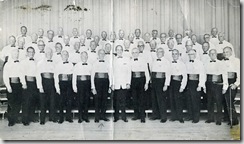[A version of this article first appeared as a post on my blog From the Front of the Choir]
Two weeks ago I wrote about how individuals choose where to stand within their part (Don't stand too close to me! - finding the right place to stand in your choir).

Then last week I looked more globally at the pros and cons of traditional choir formation vs. mixing parts up (Flying in choir formation – placing singers effectively).
Whichever approach you choose, there are still several choices to be made.
If you’ve decided on a traditional choir formation where the parts are divided into large, single sections, very often the sections stand in SATB order. However, there is no reason why it can’t be the opposite way, BTAS or even mix the sections up a little: STAB.
There are pros and cons for each of these, and maybe you might even want to vary the line up depending on the song.
You’ve decided how to order your separate sections (let’s say SATB for example), but within each section do you line singers up vertically or horizontally? You could have just four rows with one section behind the other.
SSSSSSSSSSSS
AAAAAAAAAAA
TTTTTTTTTTT
BBBBBBBBBBB
Or the more traditional way is to have each section side by side:
SSSS AAAA TTTT BBBB
SSSS AAAA TTTT BBBB
SSSS AAAA TTTT BBBB
Or maybe even:
SSSSSSSSSSSS TTTTTTTTTTT
AAAAAAAAAAA BBBBBBBBBBB
You’ve fixed on BATS for example, and maybe in traditional side by side formation. But, especially with a large choir, you might want to effectively divide the choir into two halves (or even more) to make for a more homogenous mix of voices.
So instead of lining up as BATS, you split each section into two and line up as BATSBATS (or even BATSBATSBATS).
You might even want to put some space between these two mini choirs. In rehearsal it allows each half to hear how the whole song sounds if they sing to each other separately. In performance, you can place these two mini choirs to give the audience more of a stereo effect (see 7 below).
Maybe you’ve decided to not go for the traditional division into large sections, but to mix the parts up throughout the choir. For accomplished singers you could simply create lots of SATB quartets with a single singer on each part and have them cosy up to each other to form the choir.
But if your singers are not that experienced, you may decide to make these small groups a little larger with more than one person on each part (for support). As you put more and more singers on each part, you will eventually end up with option 3 above which is a little more traditional.
For mixed formation, you can use option 4 above and have small quartets nicely positioned to make up your choir. But you could also decide to let people stand at random, wherever they want.
The advantage of this is that it improves singers’ confidence in being able to sing their part just about anywhere standing next to any other part or parts. This is great for rehearsals.
The big disadvantage, especially in performance, is that there might be ‘hot spots’ where all the Altos, say, gravitate to whereas the Tenors might be scattered more randomly.
Whichever approach you use, how do you decide which singers stand next to which singers? In traditional formation, you’ll need to decide how, for example, which Sopranos stand next to which other Sopranos. In mixed formation, you’ll need to decide which singers make up each quartet.
Some things to consider are:
Many of the choices you make will be influenced by where and how you are performing.
I’d love to hear of your experiences with choir formations. Have you done anything you consider to be very unusual? Have you adapted to venues or do you always to do the same old thing? As a singer, do you find this moving about exciting or scary? Are some formations better than others? Do leave a comment.
Chris Rowbury
website: chrisrowbury.com
blog: blog.chrisrowbury.com
Facebook: Facebook.com/ChrisRowbury
Twitter: Twitter.com/ChrisRowbury
Monthly Music Roundup: Tinyletter.com/ChrisRowbury